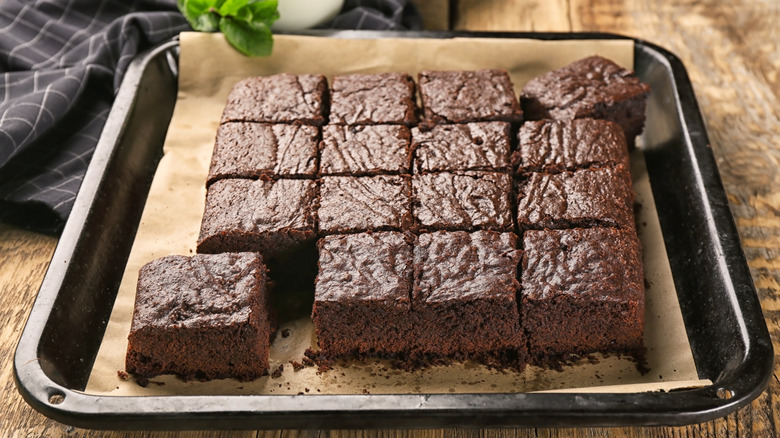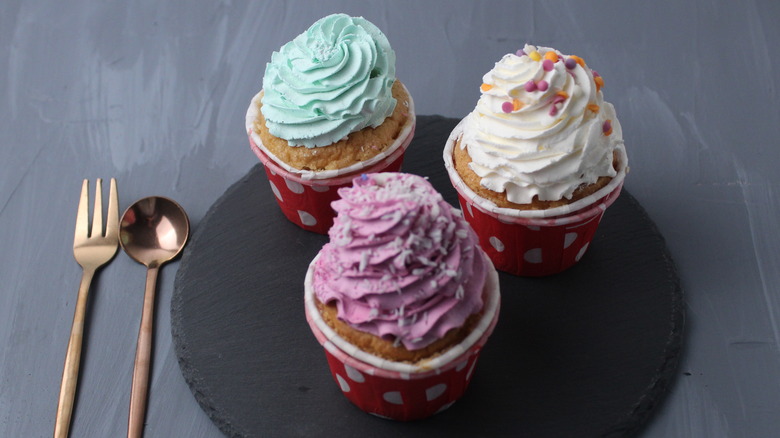The First Step To Doubling A Recipe, According To Ina Garten
Baking is finicky. It's an exact science that can frustrate cooks that typically like to wing it in the kitchen. If one variable changes, it can alter the chemistry, resulting in subpar baked goods. Factors like altitude, temperature, proper measuring, and following a good recipe can impact baking, as can assuming you can easily double the batch.
During an "Ask Ina" segment on YouTube, Ina Garten was asked whether doubling or tripling a baked recipe can impact the results. Although Garten couldn't explain the scientific reasons why, she confirmed that multiplying all the ingredients by a common number doesn't work in some recipes because there's a lot of trial and error if you want to increase the batch size with similar results.
Using an example, Garten explained that, at her former market The Barefoot Contessa, she attempted to multiply the famous sheet pan brownies to increase the batch size from 12 to 200 and ended up with a "mess." To avoid a similar fate, Garten suggests testing a double batch "when it doesn't matter," meaning you aren't hosting or planning on bringing the baked good to a party. Based on the outcome, adjust the recipe until you get it right, and eat a lot of delicious baked goods in the process.
Additional tips for doubling a recipe
It's important to know that recipes calling for baking soda and baking powder are the trickiest to double and may require some fifth grade math. Cakes, brownies, muffins, biscuits, and any baked goods using those chemical leaveners will likely need some adjustments to ensure they rise properly.
An excellent place to start if you plan to double any recipe calling for these ingredients is to use 1 to 1¼ teaspoons of baking powder for every cup of all-purpose flour you add. For recipes containing baking soda, use ¼ teaspoon for every cup of all-purpose flour. Some recipes with an acid, like buttermilk, sour cream, kefir, or citrus, will include both leaveners. In those instances, you'll need an additional ¼ to ½ teaspoon of baking soda for every cup of buttermilk added to the recipe (not to mention a piece of paper and a pencil to keep track).
It's also recommended to weigh your ingredients rather than use the traditional scoop and level method. The latter is not as accurate and can unintentionally increase the flour content by as much as 30%, resulting in a drier texture, especially as you increase the batch size.
If your limited oven space prevents you from baking the entire double batch of cookies simultaneously, refrigerate the excess dough while you wait. A hot kitchen will make the cookies increasingly flatter and spread out the dough the longer it sits out. Similarly, if you need to reuse cookie sheets, ensure they are cool before baking another batch. You can run them under cold water to cool them down quickly, but just be sure to dry them before portioning out the dough.
How to successfully cut a recipe in half
On the other side of the spectrum, there are times when you don't want to make a whole batch, and the recipe needs to be cut in half to avoid waste or singlehandedly eating three dozen gooey chocolate chip cookies right when they come out of the oven.
The easiest way to cut a recipe in half is to use a digital scale. It's much easier to divide whole numbers than fractions, and as mentioned above, weighing is a more accurate form of measuring.
If you don't have a scale, grab that paper and pencil. Since fractions can get tricky to divide, sometimes you need to convert the measurement to another unit to make small batch baking easier. For instance, if the original recipe calls for 1 tablespoon of baking soda and you don't have a ½ tablespoon measure, convert 1 tablespoon into 3 teaspoons, then cut that in half. Similarly, ¼ cup flour equals 4 tablespoons, so you'll need 2 tablespoons for the smaller recipe. In a pinch, the internet can also help with conversions.
An odd number of eggs can be tricky to divide, however. If the complete batch calls for one egg, beat it first to incorporate the white and yolk, then weigh 25 grams or measure two tablespoons since a whole large egg roughly contains ¼ cup. If the math gets too complicated, remember that baked goods freeze and defrost beautifully so maybe it's best to proceed with the full amount.



